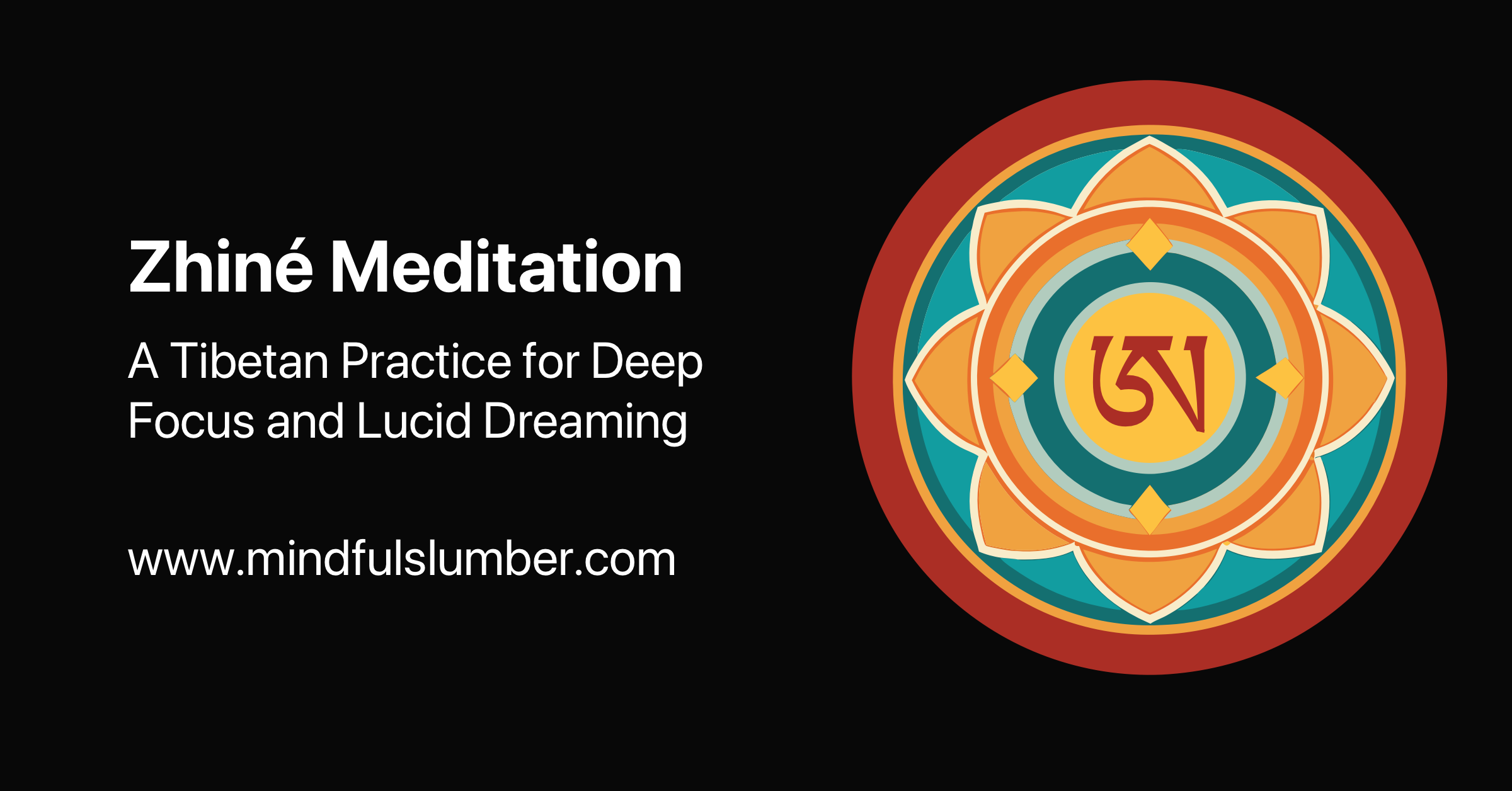In Tibetan Buddhist practice, cultivating concentration isn’t just for enhancing meditation—it’s the key to unlocking lucidity in dreams and finding greater stability in waking life. At the heart of this journey is zhiné, or calm abiding, a practice that steadies the mind and paves the way for deeper spiritual insight. One of the simplest and most powerful tools used in this practice is the Tibetan letter “ཨ” (A), an ancient symbol that represents primordial sound and openness.
But the significance of “ཨ” goes beyond its symbolism. By training your focus on this sacred letter, you begin to develop the mental discipline needed to overcome the habitual distractions and emotional reactions that often pull us off course.
Why the Tibetan Letter “ཨ”?
The letter “ཨ” is one of the most sacred symbols in Tibetan Buddhism, representing the primordial sound from which all things arise. For the purposes of zhiné, however, “ཨ” serves a more practical role: as an anchor for concentration. The point isn’t to get lost in the symbol’s meaning, but to use it as a tool for sharpening the mind’s focus.
While nearly any object can serve this purpose—such as the breath, a mantra, or a visual image—choosing a sacred object like “ཨ” connects the mind to something beyond the ordinary. This connection adds a sense of reverence to the practice, transforming what could be a mundane concentration exercise into something more profound.
Understanding Zhiné: The Practice of Calm Abiding
Zhiné (Tibetan: ཞི་གནས, meaning “calm abiding”) is a concentration practice foundational to many Tibetan meditative traditions, including dream yoga. Its purpose is to quiet the mind, stabilize the attention, and develop deep focus, which is crucial for both waking mindfulness and lucid dreaming.

There are three stages in the development of zhiné:
Forceful Zhiné (བརྩོན་འགྲུས་ཀྱི་ཞི་གནས): This initial stage requires effort and discipline to keep the mind on the chosen object. The mind frequently wanders, and you must bring it back, again and again, to the object of concentration—like the Tibetan letter “ཨ.”
Natural Zhiné (རང་བྱུང་གི་ཞི་གནས): As concentration deepens, effort becomes less necessary. The mind naturally stays focused on the object without frequent distractions. In this stage, practice feels more effortless, and the mind begins to stabilize in a relaxed yet alert state.
Ultimate Zhiné (མཐར་ཐུག་གི་ཞི་གནས): The final stage transcends the need for an external object. The mind abides calmly within itself, resting in its natural state without effort. This is the level where the mind no longer relies on an object of concentration and simply remains present and aware.
Developing zhiné is essential for dream yoga practitioners. As your mind stabilizes, dreams become longer, more vivid, and easier to recall. Lucidity—the awareness that you’re dreaming—naturally arises as the mind becomes accustomed to remaining present, whether in waking or dreaming states.
How to Practice Zhiné with the Letter “ཨ”
Mindful Slumber: Guided Zhiné Meditation
If you’re ready to begin zhiné practice, here’s a step-by-step guide to using the Tibetan letter “ཨ” as your object of focus:
Prepare Your Object: Write the Tibetan letter “ཨ” on a small piece of paper, about one inch square. Traditionally, the “ཨ” is white, and it’s enclosed by five concentric colored circles: the first circle (immediately around the letter) is indigo, followed by blue, green, red, yellow, and white.
Position Your Object: Attach the paper to a stick so it stands at eye level when you’re seated in meditation. Place it about a foot and a half in front of your eyes, ensuring that your gaze remains straight, neither looking up nor down.
Sit in the Five-Point Posture: To practice zhiné, sit in the five-point meditation posture:
- Legs crossed in a stable position.
- Hands folded in your lap with palms facing up, one on top of the other.
- Spine straight but relaxed, creating a sense of uplift in the body without tension.
- Head slightly tilted downward, so the neck stays aligned with the spine.
- Eyes open, gazing softly at the letter “ཨ.” Keep them relaxed—not too wide open and not fully closed.
Begin the Practice: Focus your attention on the letter “ཨ.” Resist the urge to move, even if sensations like an itch or the urge to blink arise. Let your breathing be natural, and avoid moving your body as much as possible. If tears well up in your eyes from keeping them open, allow them to flow without reacting.
At first, the mind will wander—this is normal. Simply bring it back to the object of focus each time it drifts. This is the essence of forceful zhiné, where willpower plays a key role in sustaining concentration.
Signs of Progress and Deeper Stability
As your practice deepens, you may experience unusual physical or mental phenomena. Lights, colors, or the sensation that the letter “ཨ” is vibrating or glowing may appear. These are natural occurrences as the mind begins to settle. Don’t get distracted or attached to these experiences—they are simply signs that concentration is becoming stronger.
The benefits of this practice aren’t limited to your meditation sessions. Over time, you’ll find that your waking life transforms as well. You’ll become less reactive, less prone to being swept away by emotional storms or habitual distractions. This increased mental stability and presence is one of the greatest gifts of zhiné—it allows you to navigate the challenges of life with greater clarity and calm.
In the context of dream yoga, this stability becomes invaluable. As your concentration strengthens, your dreams will become longer, more coherent, and easier to remember. Lucidity, or awareness within the dream, begins to emerge naturally. The mind’s ability to stay focused and present in waking life carries over into the dream state, helping you remain aware as you sleep.
Zhiné: A Practice for Both Dream and Waking Life
Whether you are aiming to deepen your dream yoga practice or simply seeking greater calm and focus in daily life, zhiné is a powerful practice. By concentrating on the letter “ཨ” and gradually stabilizing your mind, you not only gain control over the wandering thoughts that pull you into distraction, but you also cultivate a presence that extends beyond your waking hours.
In both dreams and waking life, a stable mind becomes your greatest ally. It protects you from being swept away by habitual emotional reactions, and it helps you develop the qualities that lead to lasting happiness and spiritual progress.
By focusing on the simple yet sacred letter “ཨ,” you begin a journey towards greater clarity, calm, and ultimately, freedom—both in the dream world and in everyday life.




